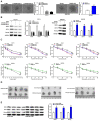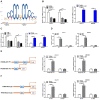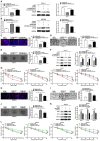SP1-induced HOXD-AS1 promotes malignant progression of cholangiocarcinoma by regulating miR-520c-3p/MYCN
- PMID: 32857725
- PMCID: PMC7485728
- DOI: 10.18632/aging.103660
SP1-induced HOXD-AS1 promotes malignant progression of cholangiocarcinoma by regulating miR-520c-3p/MYCN
Abstract
The purpose of this article is to explore the function and mechanism of HOXD-AS1 in cholangiocarcinoma. TCGA, StarBase and JASPAR were applied to predict the differential expression and molecular mechanism. The qRT-PCR was conducted to detect molecular expression. The effect of HOXD-AS1 on tumor proliferation, metastasis and stemness was measured through corresponding experiments. ChIP, luciferase reporter and RIP assays were implemented to explore the regulatory mechanism of HOXD-AS1 in CCA. In this study, HOXD-AS1 expression was significantly upregulated in CCA tissues and cells compared with control groups, respectively. Increased HOXD-AS1 was markedly correlated with lymph node invasion, advanced TNM stage and poor survival of CCA patients. Moreover, HOXD-AS1 was confirmed to be an unfavorable independent prognostic factor for CCA patients. Functionally, gain- and loss-of-function experiments demonstrated that HOXD-AS1 facilitated tumor proliferation, migration, invasion, EMT, stemness and drug resistance in vitro and in vivo. For the mechanism, transcription factor SP1-induced HOXD-AS1 upregulated oncogene MYCN through competitively binding to miR-520c-3p. Furthermore, HOXD-AS1-induced malignant phenotypes were rescued by interfering miR-520c-3p and MYCN, respectively. SP1/HOXD-AS1/miR-520c-3p/MYCN plays a vital role in initiation and progression of CCA, and HOXD-AS1 is expected to be an efficient biomarker and therapeutic target.
Keywords: HOXD-AS1; MYCN; cholangiocarcinoma; miR-520c-3p; prognosis.
Conflict of interest statement
Figures








Similar articles
-
PSMA3-AS1 induced by transcription factor PAX5 promotes cholangiocarcinoma proliferation, migration and invasion by sponging miR-376a-3p to up-regulate LAMC1.Aging (Albany NY). 2022 Jan 12;14(1):509-525. doi: 10.18632/aging.203828. Epub 2022 Jan 12. Aging (Albany NY). 2022. PMID: 35022330 Free PMC article.
-
AR-induced ZEB1-AS1 represents poor prognosis in cholangiocarcinoma and facilitates tumor stemness, proliferation and invasion through mediating miR-133b/HOXB8.Aging (Albany NY). 2020 Jan 24;12(2):1237-1255. doi: 10.18632/aging.102680. Epub 2020 Jan 24. Aging (Albany NY). 2020. PMID: 31978895 Free PMC article.
-
Long Non-coding RNA FOXD2-AS1 Promotes Proliferation, Migration, and Invasion in Cholangiocarcinoma Through Regulating miR-760/E2F3 Axis.Dig Dis Sci. 2022 Feb;67(2):546-558. doi: 10.1007/s10620-021-06876-9. Epub 2021 Feb 11. Dig Dis Sci. 2022. PMID: 33570683
-
The Role of microRNAs in Cholangiocarcinoma.Int J Mol Sci. 2021 Jul 16;22(14):7627. doi: 10.3390/ijms22147627. Int J Mol Sci. 2021. PMID: 34299246 Free PMC article. Review.
-
Role of noncoding RNAs in cholangiocarcinoma (Review).Int J Oncol. 2020 Jul;57(1):7-20. doi: 10.3892/ijo.2020.5047. Epub 2020 Apr 15. Int J Oncol. 2020. PMID: 32319584 Review.
Cited by
-
Long Non-Coding RNAs as Molecular Biomarkers in Cholangiocarcinoma.Front Cell Dev Biol. 2022 Apr 27;10:890605. doi: 10.3389/fcell.2022.890605. eCollection 2022. Front Cell Dev Biol. 2022. PMID: 35573683 Free PMC article. Review.
-
PSMA3-AS1 induced by transcription factor PAX5 promotes cholangiocarcinoma proliferation, migration and invasion by sponging miR-376a-3p to up-regulate LAMC1.Aging (Albany NY). 2022 Jan 12;14(1):509-525. doi: 10.18632/aging.203828. Epub 2022 Jan 12. Aging (Albany NY). 2022. PMID: 35022330 Free PMC article.
-
miR-520c-3p regulates IL-1β-stimulated human chondrocyte apoptosis and cartilage degradation by targeting GAS2.J Orthop Surg Res. 2021 May 29;16(1):347. doi: 10.1186/s13018-021-02466-7. J Orthop Surg Res. 2021. PMID: 34051811 Free PMC article.
-
Long noncoding HOXD-AS1: a crucial regulator of malignancy.Front Cell Dev Biol. 2025 Mar 26;13:1543915. doi: 10.3389/fcell.2025.1543915. eCollection 2025. Front Cell Dev Biol. 2025. PMID: 40206400 Free PMC article. Review.
-
Biomarkers and Management of Cholangiocarcinoma: Unveiling New Horizons for Precision Therapy.Cancers (Basel). 2025 Apr 6;17(7):1243. doi: 10.3390/cancers17071243. Cancers (Basel). 2025. PMID: 40227772 Free PMC article. Review.
References
-
- Khan SA, Davidson BR, Goldin RD, Heaton N, Karani J, Pereira SP, Rosenberg WM, Tait P, Taylor-Robinson SD, Thillainayagam AV, Thomas HC, Wasan H, and British Society of Gastroenterology. Guidelines for the diagnosis and treatment of cholangiocarcinoma: an update. Gut. 2012; 61:1657–69. 10.1136/gutjnl-2011-301748 - DOI - PubMed
Publication types
MeSH terms
Substances
LinkOut - more resources
Full Text Sources
Medical
Miscellaneous

